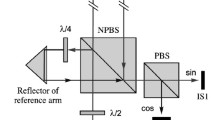Aspects of the use of a laser meter that measures pressure variations in a hydrosphere functioning as a laser-interference bottom seismograph capable of recording variations in displacements of the floor are described. The capabilities of the bottom seismograph are demonstrated in recording of seismic signals.


Similar content being viewed by others
References
N. P. Laverov, Yu. V. Roslov, L. I. Lobkovskiy, et al., “Outlook for seismic exploration in the Russian Federation,” Arktika: Ekol. Ekon., No. 4, 4–13 (2011).
D. G. Levchenko, B. Ya. Rozman, L. P. Utyakov, and M. A. Shakhramanyan, “External bottom stations for geophysical monitoring and operational warning of earthquakes and tsunamis,” Sb. Tr. MGI (1992), pp. 57–61.
J. Kasahara and S. Toshimori, “Broadband seismic observation in VENUS project,” in: Int. Workshop Scientific Use of Submarine Cables, Okinawa, Japan, (1997), pp. 126–130.
J. R. Delaney, “NEPTUNE: an interactive submarine observatory at the scale of a tectonic plate,” in: Long-Term Observations in the Oceans: OHP/ION Joint Symposium, Japan (2001), p. 309.
D. G. Levchenko, V. V. Ledenev, and A. A. Paramonov, “Modern bottom stations for seismic exploration and seismological monitoring,” Nauch. Priborostr., 13, No. 4, 70–82 (2003).
I. P. Bashilov, Yu. N. Zubko, D. G. Levchenko, et al., “Bottom geophysical observatories: methods of construction and range of application,” Nauch. Priborostr., 18, No. 2, 86–97 (2008).
G. I. Dolgigh, S. G. Dolgikh, S. N. Kovalev, et al., “Laser meter for measurements of variations in hydrosphere pressure,” Prib. Tekhn. Eksperim., No. 6, 137–138 (2005).
G. I. Dolgigh and V. E. Privalov, Lasers. Laser Systems, Dal’nauka, Vladivostok (2009).
G. I. Dolgigh, S. S. Budrin, S. G. Dolgikh, et al., “Sea internal waves and atmospheric depressions,” Dokl. Akad. Nauk, 462, No. 5, 601–604 (2015).
A. A. Plotnikov, V. V. Ovcharenko, V. A. Shvets, et al., Patent 2653099 RF, “Laser-interference bottom seismograph,” Izobret. Polezn. Modeli, No. 13 (2018).
M. N. Dubrov and V. A. Aleshin, “High-frequency laser interferometers in multicomponent measurement systems,” Zh. Radioelektr., No. 10, 7 (2000).
V. A. Shvets, “Controller-Detector of recording system of laser strain meter,” Prib. Tekhn. Eksperim., No. 1, 159–160 (2011).
L. D. Landau and E. M. Lifshits, Theoretical Physics, Vol. VII, Theory of Elasticity, Nauka, Moscow (1987).
Author information
Authors and Affiliations
Corresponding author
Additional information
Translated from Izmeritel’naya Tekhnika, No. 1, pp. 48–51, January, 2019.
Rights and permissions
About this article
Cite this article
Dolgikh, G.I., Dolgikh, S.G., Plotnikov, A.A. et al. Features of the Use of a Laser-Interference Bottom Seismograph. Meas Tech 62, 59–63 (2019). https://doi.org/10.1007/s11018-019-01586-1
Received:
Published:
Issue Date:
DOI: https://doi.org/10.1007/s11018-019-01586-1




